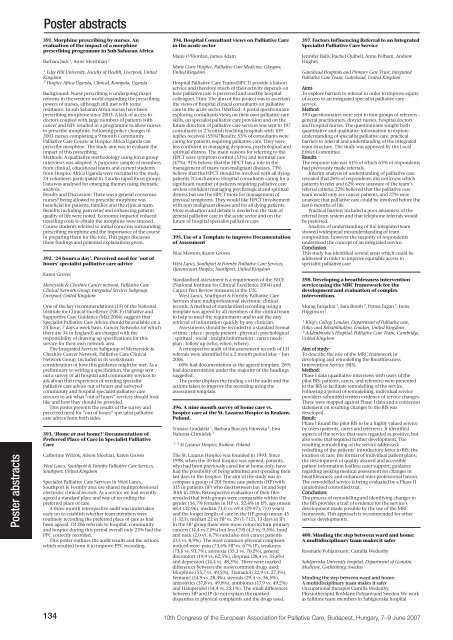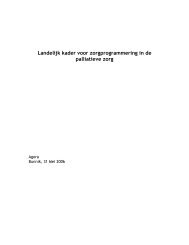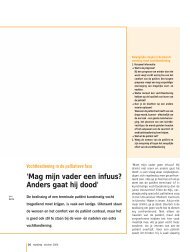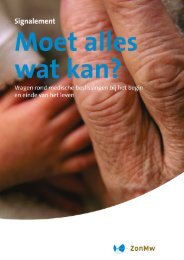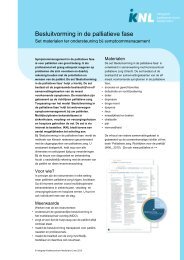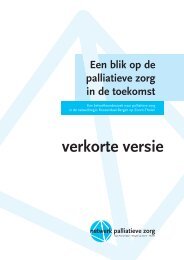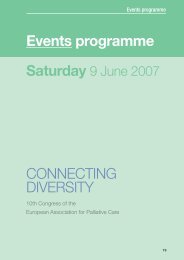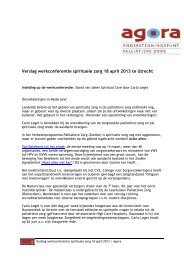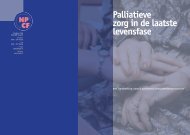Poster abstracts CONNECTING DIVERSITY
Poster abstracts CONNECTING DIVERSITY
Poster abstracts CONNECTING DIVERSITY
You also want an ePaper? Increase the reach of your titles
YUMPU automatically turns print PDFs into web optimized ePapers that Google loves.
<strong>Poster</strong> <strong>abstracts</strong><br />
<strong>Poster</strong> <strong>abstracts</strong><br />
391. Morphine prescribing by nurses. An<br />
evaluation of the impact of a morphine<br />
prescribing programme in Sub Saharan Africa<br />
Barbara Jack 1 , Anne Merriman 2<br />
1<br />
Edge Hill University, Faculty of Health, Liverpool, United<br />
Kingdom<br />
2<br />
Hospice Africa Uganda, Clinical, Kampala, Uganda<br />
Background: Nurse prescribing is undergoing major<br />
reforms in the western world expanding the prescribing<br />
powers of nurses, although still met with some<br />
resistance. In sub Saharan Africa nurses have been<br />
prescribing morphine since 2003. A lack of access to<br />
doctors coupled with large numbers of patients with<br />
cancer and HIV resulted in a programme to allow nurses<br />
to prescribe morphine. Following policy changes in<br />
2003 nurses completing a 9 month Community<br />
Palliative Care Course at Hospice Africa Uganda can<br />
prescribe morphine. The study aim was to evaluate the<br />
impact of this prescribing.<br />
Methods: A qualitative methodology using focus group<br />
interviews was adopted. A purposive sample of members<br />
from clinical, educational teams and current students<br />
from Hospice Africa Uganda were recruited to the study.<br />
24 volunteers participated in 3 audio taped focus groups.<br />
Data was analysed for emerging themes using thematic<br />
analysis.<br />
Results and Discussion: There was a general consensus<br />
nurses? being allowed to prescribe morphine was<br />
beneficial for patients, families and the clinical team.<br />
Benefits including pain relief and enhancing patients<br />
quality of life were noted. Economic impactof reduced<br />
travelling costs to obtain the morphine were stressed.<br />
Course students referred to initial concerns surrounding<br />
prescribing morphine and the importance of the course<br />
in preparing them for the role. This paper discusses<br />
these findings and potential explanations given.<br />
392. ‘24 hours a day’. Perceived need for ‘out of<br />
hours’ specialist palliative care advice<br />
Karen Groves<br />
Merseyside & Cheshire Cancer network, Palliative Care<br />
Clinical Network Group, Integrated Services Subgroup,<br />
Liverpool, United Kingdom<br />
One of the key recommendations (15) of the National<br />
Institute for Clinical Excellence (NICE) Palliative and<br />
Supportive Care Guidance (Mar 2004) suggests that<br />
Specialist Palliative Care Advice should be available on a<br />
24 hour, 7 days a week basis. Cancer Networks (of which<br />
there are 34 in England) are charged with the<br />
responsibility of drawing up specifications for this<br />
service for their own network area.<br />
The Integrated Services Subgroup of Merseyside &<br />
Cheshire Cancer Network, Palliative Care Clinical<br />
Network Group, included in its workstream<br />
consideration of how this guidance might be met. As a<br />
preliminary to writing a specification, the group sent<br />
out a survey of all hospital and community services to<br />
ask about their experience of needing specialist<br />
palliative care advice out of hours and surveyed<br />
community and hospital specialist palliative care<br />
services to ask what “out of hours” services should look<br />
like and how they should be provided.<br />
This poster presents the results of the survey and<br />
perceived need for “out of hours” specialist palliative<br />
care advice from both sides.<br />
393. ‘Home or not home?’ Documentation of<br />
Preferred Place of Care in Specialist Palliative<br />
Care<br />
Catherine Wilcox, Alison Meehan, Karen Groves<br />
West Lancs, Southport & Formby Palliative Care Services,<br />
Southport, United Kingdom<br />
Specialist Palliative Care Services in West Lancs,<br />
Southport & Formby area use shared multiprofessional<br />
electronic clinical records. As a service we had recently<br />
agreed a standard place and way of recording the<br />
preferred place of care.<br />
A three month retrospective audit was undertaken<br />
early on to establish whether team members were<br />
routinely recording the preferred place of care as had<br />
been agreed. Of 206 referrals to hospital, community<br />
and hospice during this period overall only 23% had the<br />
PPC correctly recorded.<br />
This poster outlines the audit results and the actions<br />
which resulted from it to improve PPC recording.<br />
394. Hospital Consultant views on Palliative Care<br />
in the acute sector<br />
Maire O’Riordan, James Adam<br />
Marie Curie Hospice, Palliative Care Medicine, Glasgow,<br />
United Kingdom<br />
Hospital Palliative Care Teams(HPCT) provide a liaison<br />
service and therefore much of their activity depends on<br />
how palliative care is perceived and used by hospital<br />
colleagues.?Aim: The aim of this project was to ascertain<br />
the views of hospital clinical consultants on palliative<br />
care in the acute sector.?Method: A postal questionnaire<br />
exploring consultants views on their own palliative care<br />
skills, on specialist palliative care provision and on the<br />
future direction of palliative care services was sent to 197<br />
consultants in 2 Scottish teaching hospitals with 109<br />
replies received (55%)?Results: 53% of consultants were<br />
caring for patients requiring palliative care. They were<br />
less confident in managing dyspnoea, psychological and<br />
spiritual distress. The main reasons for referring to the<br />
HPCT were symptom control (53%) and terminal care<br />
(47%). 91% believe that the HPCT has a role in the<br />
management of many non-malignant diseases. 73%<br />
believe that the HPCT should be involved with all dying<br />
patients.?Conclusions: Hospital consultants caring for a<br />
significant number of patients requiring palliative care<br />
are less confident managing psychological and spiritual<br />
distress but use the HPCT more for management of<br />
physical symptoms. They would like HPCT involvement<br />
with non malignant disease and for all dying patients.<br />
More evaluation and debate is needed on the state of<br />
general palliative care in the acute sector and on the<br />
future of hospital specialist palliative care<br />
395. Use of a Template to improve Documentation<br />
of Assessment<br />
Niaz Memon, Karen Groves<br />
West Lancs, Southport & Formby Palliative Care Services,<br />
Queenscourt Hospice, Southport, United Kingdom<br />
Standardised assessment is a requirement of the NICE<br />
(National Institute for Clinical Excellence 2004) and<br />
Cancer Peer Review measures in the U.K.<br />
West Lancs, Southport & Formby Palliative Care<br />
Services share multiprofessional electronic clinical<br />
records. A method of standardised recording using a<br />
template was agreed by all members of the clinical team<br />
to help to meet the requirements and to aid the easy<br />
retrieval of information quickly by any clinician.<br />
Assessments should be recorded in a standard format<br />
of time : place : people present : physical : psychological<br />
: spiritual : social : insight/information : carers needs :<br />
plan : follow up (who, when, where).<br />
A retrospective audit of the assessment records of 131<br />
referrals were identified for a 2 month period May – Jun<br />
2006.<br />
60% had documentation as the agreed template. 26%<br />
had documentation under the majority of the headings<br />
suggested.<br />
The poster displays the finding s of the audit and the<br />
actions taken to improve the recording using the<br />
assessment template.<br />
396. A nine month survey of home care vs.<br />
hospice care at the St. Lazarus Hospice in Krakow,<br />
Poland.<br />
Tomasz Gradalski 1 , Barbara Burczyk Fitowska 2 , Ewa<br />
Nalezna-Chmielek 3<br />
1– 3<br />
St Lazarus Hospice, Krakow, Poland<br />
The St. Lazarus Hospice was founded in 1993. Since<br />
1998, when the 30 bed hospice was opened, patients,<br />
who had been previously cared for at home only, have<br />
had the possibility of being admitted and spending their<br />
last days in the hospice. The aim of the study was to<br />
compare a group of 201 home care patients (HP) with<br />
315 in-patients (IP) who died between Jan 1st and Sept<br />
30th in 2006. Retrospective evaluation of their files<br />
revealed that both groups were comparable within the<br />
gender (56,7% females in HP vs. 52,4% in IP), age (mean<br />
68,4 (32-96), median 71,0 vs. 69,4 (29-97), 71,0 years)<br />
and the longer length of care in the HP group (mean 45<br />
(1-323), median 22 in HP vs. 29 (1-712), 13 days in IP).<br />
In the HP group there were more colon/rectum primary<br />
cancers (14,4 vs.7,0%) but less CNS (4,5 vs. 9,5%), head<br />
and neck (2,0 vs. 6,7%) and also non cancer patients<br />
(0,5 vs. 8,9%). The most common physical complains<br />
noticed were: pain (73,6% HP vs. 67% IP), weakness<br />
(73,6 vs. 93,7%), anorexia (35,3 vs. 70,2%), general<br />
discomfort (19,9 vs. 62,5%), dyspnea (28,4 vs. 35,6%)<br />
and depression (14,4 vs. 48,3%). There were marked<br />
differences between the most common drugs used:<br />
Morphine (55,7 vs. 49,5%), Tramadol (22,9 vs. 27,3%),<br />
Fentanyl (14,9 vs. 28,3%), steroids (29,4 vs. 56,5%),<br />
anxiolytics (37,8 vs. 49,8%), antibiotics (17,9 vs. 49,2%)<br />
and Haloperidol (14,4 vs. 25,1%). The small differences<br />
between HP and IP do not explain the marked<br />
disparities in physical complaints and the drugs used.<br />
397. Factors Influencing Referral to an Integrated<br />
Specialist Palliative Care Service<br />
Jennifer Balls, Rachel Quibell, Anne Pelham, Andrew<br />
Hughes<br />
Gateshead Hospitals and Primary Care Trust, Integrated<br />
Palliative Care Team, Gateshead, United Kingdom<br />
Aims<br />
To explore barriers to referral in order to improve equity<br />
of access to an integrated specialist palliative care<br />
service.<br />
Method<br />
393 questionnaires were sent to four groups of referrers -<br />
general practitioners, district nurses, hospital doctors<br />
and hospital nurses. The questionnaire sought both<br />
quantitative and qualitative information to explore<br />
understanding of specialist palliative care, practical<br />
barriers to referral and understanding of the integrated<br />
team structure. The study was approved by the Local<br />
Ethics Committee.<br />
Results<br />
The response rate was 51% of which 63% of respondents<br />
had previously made referrals.<br />
Interim analysis of understanding of palliative care<br />
revealed that 26% of respondents did not know which<br />
patients to refer and 62% were unaware of the team’s<br />
referral criteria. 22% believed that the palliative care<br />
team would only see cancer patients, and 27% were<br />
unaware that palliative care could be involved before the<br />
last 6 months of life<br />
Practical barriers included a poor awareness of the<br />
referral form system and that telephone referrals would<br />
be preferred.<br />
Analysis of understanding of the integrated team<br />
showed widespread misunderstanding of team<br />
composition, however the majority of respondents<br />
understood the concept of an integrated service.<br />
Conclusion<br />
This study has identified several areas which could be<br />
addressed in order to improve equitable access to<br />
specialist palliative care.<br />
398. Developing a breathlessness intervention<br />
service using the MRC framework for the<br />
development and evaluation of complex<br />
interventions.<br />
Morag Farquhar 1 , Sara Booth 2 , Petrea Fagan 2 , Irene<br />
Higginson 1<br />
1<br />
King’s College London, Department of Palliative care,<br />
Policy and Rehabilitation, London, United Kingdom<br />
2<br />
Addenbrooke’s Hospital, Palliative Care Team, Cambridge,<br />
United Kingdom<br />
Aim of study:<br />
To describe the role of the MRC framework in<br />
developing and remodelling the Breathlessness<br />
Intervention Service (BIS).<br />
Method:<br />
Phase I data (qualitative interviews with users of the<br />
pilot BIS: patients, carers, and referrers) were presented<br />
to the BIS to facilitate remodelling of the service.<br />
Following a period of remodelling, individual service<br />
providers submitted written evidence of service changes.<br />
These were mapped against Phase I data and a consensus<br />
statement on resulting changes to the BIS was<br />
developed.<br />
Result:<br />
Phase I found the pilot BIS to be a highly valued service<br />
by users (patients, carers and referrers). It identified<br />
aspects of the service that users regarded as positive, but<br />
also some that required further development. The<br />
resulting remodelling of the service addressed:<br />
redrafting of the patients’ introductory letter to BIS; the<br />
location of care; the format of individual patient plans;<br />
the development of quality assured and accessible<br />
patient information leaflets; carer support; guidance<br />
regarding seeking medical assessment for changes in<br />
breathlessness; and enhanced inter-professional liaison.<br />
The remodelled service is being evaluated by a Phase II<br />
randomised controlled trial.<br />
Conclusion:<br />
The process of remodelling and identifying changes to<br />
the BIS provides a trail of evidence for the service’s<br />
development made possible by the use of the MRC<br />
framework. This approach is recommended for other<br />
service developments.<br />
400. Minding the step between ward and home:<br />
A multidisciplinary team makes it safer<br />
Rosmarie Pohjanvuori, Camilla Wedenby<br />
Sahlgrenska University hospital, Department of Geriatric<br />
Medicine, Gothenburg, Sweden<br />
Minding the step between ward and home:<br />
A multidisciplinary team makes it safer<br />
Occupational therapist Camilla Wedenby,<br />
Physiotherapist RosMarie Pohjanvuori Sweden We work<br />
as fulltime team members in Sahlgrenska hospital<br />
134 10th Congress of the European Association for Palliative Care, Budapest, Hungary, 7–9 June 2007


